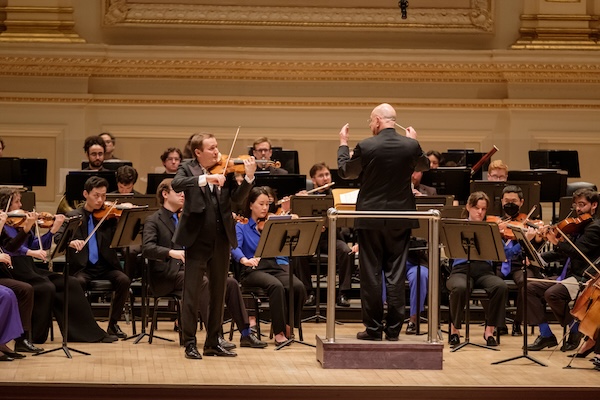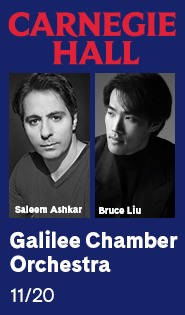When violinists compose: Botstein, The Orchestra Now serve up an intriguing if uneven sampler

Legendary pianists could be pretty good composers, too. Perhaps you’ve heard of Mozart, Chopin, Liszt, Rachmaninoff…
But what about violinists? Conductor and musical archaeologist Leon Botstein decided to find out, and the result was Wednesday’s concert at Carnegie Hall by Botstein and The Orchestra Now, an ensemble of highly capable players in a graduate program at Bard College.
Violin fans will always love their dazzling Sarasate and their tuneful Wieniawski, but when it comes to association with the big leagues of composers, few can match Joseph Joachim (1831-1907), the violin muse of high German Romanticism; Eugène Ysaÿe (1858-1931), champion of composers as different as Franck and Debussy; or George Enescu (1881-1955), Romania’s gift to the bubbling music scene of 1920s Paris.
Today, these violin greats are remembered more for their midwifery of others’ masterpieces than for their own orchestral compositions. Botstein and his players set out to remedy that on Wednesday, performing compact works by Joachim and Ysaÿe, and Enescu’s ambitious, nearly hour-long Symphony No. 2.
Nikita Boriso-Glebsky, a proficient violinist making his Carnegie Hall debut, gave energetic and stylish renditions of Joachim’s Variations for Violin and Orchestra and Ysaÿe’s Violin Concerto in D minor, a recently discovered piece receiving its first performance in New York City.
The concert proved at least that these famous fiddlers knew their way around a symphony orchestra, and it offered a live listen to some music worthy of hearing again. It began with a taste of mid-20th-century neoclassicism, the Partita for Orchestra by Grażyna Bacewicz (1909-1969), composed in 1955, just as the Lithuanian-Polish violinist was turning away from her international performing career in favor of composing and teaching full time.
The Partita’s four brief movements consisted of a shadowy Praeludium, with an expressive melody unfolding over a steady pizzicato beat in low strings; an airy Toccata glinting with piccolo and xylophone; an Intermezzo, in which plaintive wind solos drifted through a dream scene of string tremolo and harp; and a snappy Rondo whose interplay among the sections rivaled Prokofiev’s “Classical” Symphony for wit and energy.
Brahms composed his immortal Violin Concerto for Joachim, then characteristically ignored the latter’s advice to make the solo part more showy. Joachim eventually had his say in these Variations, taking many pointers from his friend in orchestration and transformation of an eight-bar theme, and adding his own brand of elegant virtuosity.
Botstein and his players brought out the piece’s Brahmsian, autumnal hues, while soloist Boriso-Glebsky sang, slashed and scaled his way through the twenty-odd brief variations in a well-contrasted and -paced performance.
Ysaÿe’s most original and enduring contributions to the repertoire are his six sonatas for unaccompanied violin of 1923, but music reference books credit him with no fewer than eight concertos, composed much earlier in his career. The one in D minor that was performed Wednesday night was described in the program as written in 1884 and “recently discovered,” without further explanation.
In any case, the one-movement work struck a Mendelssohnian balance between classical form and Romantic emotion, with a healthy admixture of virtuoso acrobatics à la Vieuxtemps. Boriso-Glebsky made his entrance with a formidable passage in tenths, and continued to impress thereafter with passionate surges, bold double- and triple-stops, and flashing scales. His cantabile passages sang sweetly and soared high.
After the concerto’s tidy ending—more like a first-movement close than a brilliant finale—Boriso-Glebsky responded to the applause with a muscular encore, the “Les Furies” movement from Ysaÿe’s Solo Sonata No. 2.
Intermission allowed setting up for the Enescu symphony—unusually, with two harps, celesta and harmonium clustered at center stage, face to face with the conductor. Presumably this gave these peripheral instruments a fighting chance to make their effects heard amid the piece’s extravagant orchestration, since, although the 1914 symphony was contemporary with The Rite of Spring, its sound world and harmonic language were more Strauss than Stravinsky.
Enescu tried out the piece in Bucharest soon after its completion, then set it aside pending revision—which it never received. That, plus the restless Straussian harmonies, gave the piece a certain molten, unfinished quality that Wednesday’s performance, though well put together, did little to resolve.
From moment to moment, however, there was much to admire in the first movement’s bold opening in descending figures, striking melodies set aglow by the harps, elemental surges throwing off piccolo sparks, and pianissimo ending on a bit of tremolo and a drum roll.
A little more attention to the marking “Andante giusto” (Slow, strict tempo) might have kept the second movement from wandering as horns followed the clarinet solo, leading to a woodwind interlude. The strings swelled, reinforced by horns, then fell back into a desolate dialogue.
The final two movements, played without a break, both included “marziale” (march-like) in their tempo markings—one funereal with muffled drums, the other harsh and sarcastic at first, but eventually striving toward triumph. The tension and suspense of the former was twice shattered by brass outbursts, a well-executed effect.
The finale, brilliant with screeching winds and grotesque imagery à la Berlioz, felt overlong, perhaps owing to not enough contrast of mood between its episodes, and what sounded like four or five endings before the actual one. It left one wondering, must we content ourselves with this draft of the work, or could some latter-day Enescu apply the shears to good effect?


